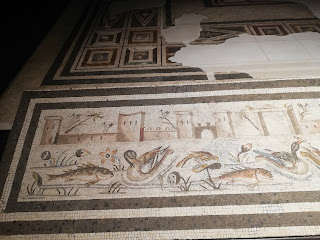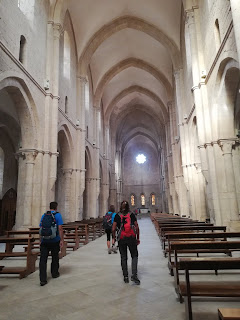Road (to) from Rome Day 5: Sezze - Abbazia di Fossanova (Priverno)
18 km walked
From today's starting point at the cathedral in Sezze we walked through the town and past a rock known as the Pope's Seat, because in the days of the Papal State he could sit up there and survey his realm below. A rocky trail clung to the side of the hill with sweeping views over the flat plain of the Agro Pontino below, a malarial swamp until it was drained in 1933.
We descended onto a secondary road and stopped at the border between the municipalities of Sezze and Priverno for a cold drink and a brief ceremony, in which the pilgrim staff that has travelled all the way from Canterbury, handed on from one walker to the next, was symbolically handed across the town limits to authorities from the next municipality. Then we proceeded on to Priverno, where we were welcomed by a bugler, a town crier reading out a proclamation, and young ladies in Renaissance costume handing out drinks and snacks. We all then proceeded in solemn procession all the way to the town hall at the top of the hill, much to the consternation of the local motorists!
The town of Priverno was historically home to three "hospitals", what we now call hostels, for pilgrims: the Templars, the Cistercians, and Saint Antoine de Viennes. So it was appropriate that the town should provide us with such fantastic hospitality! We were also treated to a meeting with the mayor and a tour of the fascinating archaeological museum featuring finds from ancient Volscian and Roman Privernum. The highlight of the museum is a floor mosaic from a patrician domus illustrating scenes of the Nile River. Including one of a naughty little pygmy mooning a companion he appears to have just defeated in some sort of contest!
The museum building itself was quite fascinating with its art nouveau ceilings. But the highlight of the day was the Abbey of Fossanova, where we ended today's walk.
The Abbey of Fossanova was built in the years between 1163 and 1208 on the site of a former Benedictine abbey which had been constructed in the sixth century A.D. on the site of a Roman villa. When the site was donated to the Cistercians in 1135, the first thing they did was built a new canal (the fossa nova of the name) to drain the swamp. Consecrated by Pope Innocent III in 1208, the church is considered one of the first constructions in Italy in Gothic style, closely modeled after St. Bernard's original Cistercian Abbey in Clairvaux, Burgundy, France.
St. Thomas Aquinas stopped at the abbey on his way to the Second Council of Lyons, but fell ill and died here on March 9, 1274. In 1368 his remains were removed from the abbey to the Jacobins Church in Toulouse, but his presence may still be felt at Fossanova: the hostel where he stayed (and died) was converted into a chapel in the 17th century.
Like the Abbey of Valvisciolo, which we saw yesterday, the Abbey of Fossanova is connected with the Knights Templar, whose history is closely related to that of the Cistercians. The order known as the Knights Templar, the Pauperes commilitones Christi Templique Salomonici (Poor Fellow-Soldiers of Christ and of the Temple of Solomon) was a military order based on the Temple Mount in Jerusalem, founded in 1119 for the protection of pilgrims on their way to the Holy Land. The order was a favoured charity throughout Christendom in the Middle Ages, rapidly accumulating wealth, membership and power and managing a large economic structure throughout Christendom, inventing new financial techniques; the Templars are in fact now considered to have practiced one of the earliest forms of banking. But their close ties to the Crusades meant that when the Holy Land was lost to the "infidels", support for the order faded; King Philip IV of France, who was deeply in debt to the order, took advantage of this trend to destroy the Templars and thereby cancel his own debt, burning the last Grand Master of the order, Jacques de Molay, at the stake in 1314.
Templar symbols may still be seen at Fossanova, such as the Merel's Board, three concentric squares joined by perpendicular segments, representing the three degrees of initiation in esoterism and druidism, and the Omphalos or Sacred Centre.
Were these really sacred symbols - or were they board games of some kind, to entertain the builders of the Abbey during their breaks?
Outside the Abbey is a marker: 100 kilometres from Rome.
There has been so much to see and do in the first hundred kilometres south of Rome! Who knows how many more treasures, and how many more adventures, await us on the Via Francigena of the south, before we reach Santa Maria di Leuca, another 800 kilometres down the road!

























Hi Joanne,
ReplyDeleteVery much enjoying your blog. Just wondering how you are navigating the region/finding the best paths to walk?
I visit Priverno and the Pontinia area often and wish to explore it more although I have struggled to find paths to walk on. Do you have any maps/tips/websites where you find your walking routes?
Thanks,
Dave
Hi Dave! In this case I was walking on the Via Francigena, a well-established route. You can find information on the itinerary and GPS tracks of the route on https://www.viefrancigene.org/en/walking/. For information on other long-distance walking routes in Italy, you can refer to https://camminiditalia.org/, though it is not a complete list. When I hear about a particular route, via social media or friends, I google it and often find that every "cammino" has one or more websites dedicated to it, from which to garner information, advice, maps, GPS tracks, and so on.
ReplyDeleteThis was my first time passing through the Priverno area; I don't live in that part of Italy and am not so familiar with it, so I can't help you with any suggestions regarding specific trails in that area! Sorry!